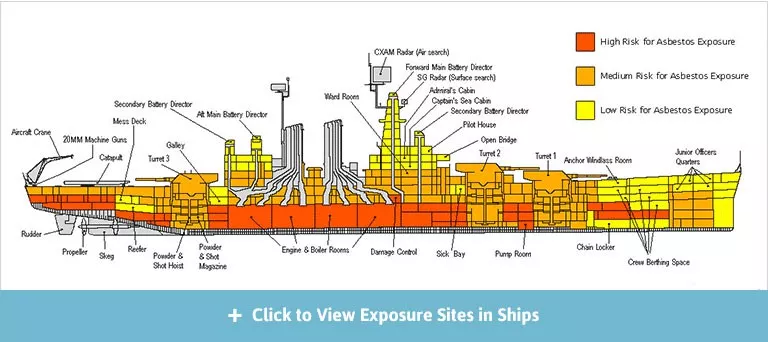Asbestos Exposure Among Navy Veterans
Navy mesothelioma
Navy veterans still are paying the price today. The Navy finally stopped filling ships with asbestos in the early ’70s, but those vessels remained in use for many years after production stopped.

Prior to the U.S. Environmental Protection Agency (EPA) regulating the use of asbestos, shipbuilders were using it in hundreds of applications. Engine rooms, boiler rooms, weapons and ammunition storage rooms – anywhere that needed heat resistance – all had the mineral. It was in the mess halls, the sleeping quarters and navigation rooms, too. Products like cables, gaskets and valves had asbestos. It covered the pipes, pumps, motors, condensers and compressors that helped run a ship. It was in the wall insulation and the floors.
The construction, demolition, repair or renovation of ships – or naval buildings on land – exposed Navy personnel to the microscopic asbestos fibers. As ships aged, asbestos became brittle. Any disturbance, especially in the close quarters of ships and submarines, would make the fibers airborne.Sailors aboard warships often slept in bunks that were below asbestos-covered pipes, forcing them to shake off the dusty material on a regular basis. The Marines that often were transported on the same ships were exposed, too. Personnel who worked below deck on ships were at the highest risk because of where the most heat-resistant asbestos was used, nearest the engine and boiler rooms.
Navy Asbestos Medical Surveillance Program
In the late 1970s, the U.S. Navy launchedthe Asbestos Medical Surveillance Program (AMSP), a comprehensive program that monitors the health of service members and civilian employees of the U.S. Department of the Navy who were exposed to asbestos.
AMSP helps the Navy keep records of exposed members so it can provide regular medical examinations and chest X-rays to detect asbestos-related diseases early on. Early detection is crucial for successfully treating mesothelioma, a deadly cancer that typically takes decades to develop after asbestos exposure.
When an asbestos incident occurs, medical officers can place anyone affected into the AMSP. The medical officer, usually the AMSP manager on a ship or in small facilities, will oversee the initial surveillance exam and the periodic exams that follow.
Once enrolled in the program, Navy service members fill out a questionnaire with information about their work history and any past or current exposures to asbestos. The form also asks a series of questions about lung health to identify early warning signs of asbestos-related disease, such as shortness of breath or a persistent cough.
Next, members visit an occupational health doctor for a physical exam. The doctor evaluates the member’s health and lung function, and then performs an X-ray that may reveal signs of an asbestos-related condition. Another common test, known as spirometry, helps the doctor assess how well the lungs are functioning.
With the results of the questionnaire and initial physical exam, doctors can identify asbestos-related health problems. The doctor documents the results of the exam and tests to use as a reference for future health exams.
If new symptoms appear or existing symptoms worsen, it may indicate an undiagnosed asbestos-related disease. Further testing allows doctors to make the correct diagnosis and promptly get members started with treatment.
No comments:
Post a Comment